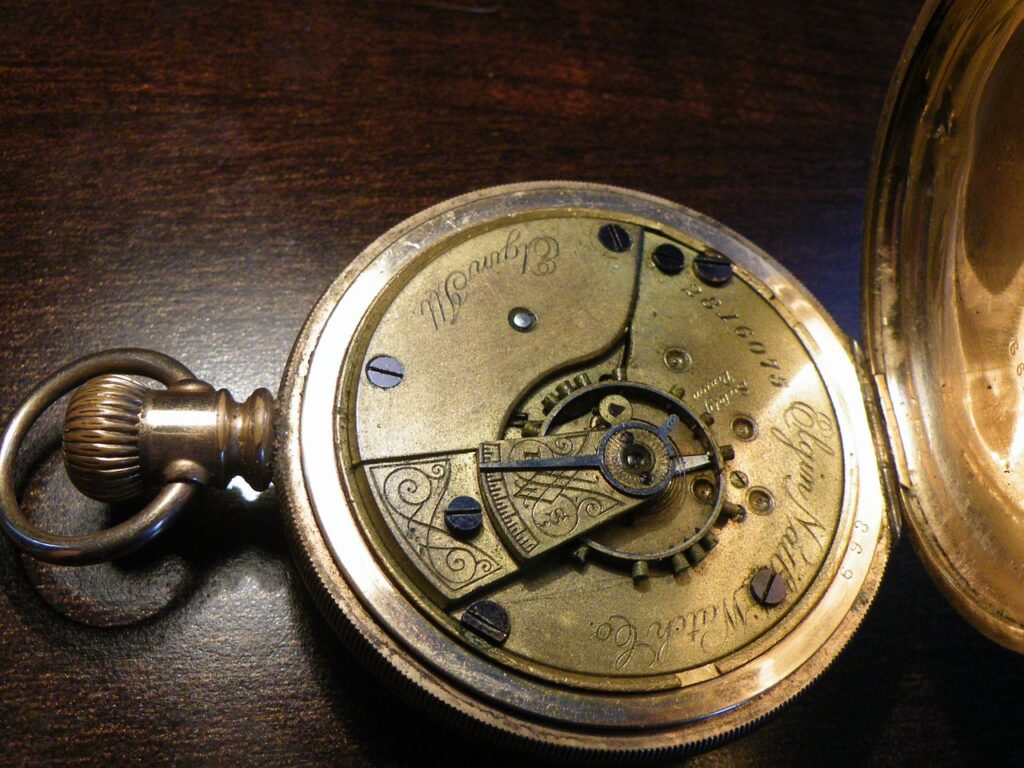Many people have been asking When Was The Pocket Watch was Invented, and in this guide, we cover the history of the pocket watch.
The pocket watch is one of the finest inventions ever to grace the watch industry.
Since it was unveiled in the 15th century, the pocket watch has remained a symbol of affluence.
Even today, the pocket watch still commands massive attention and respect.
Because it offers an unprecedented level of class and prestige, it’s easy to see why this incredible invention is highly sought after by collectors, gentlemen, and distinguished ladies worldwide.
Read on to learn more about the history of pocket watches and why they are still revered among watch collectors and professionals.
The evolution of pocket watch
Pocket watches have a brilliant and fascinating history.
Their origin dates back to their use by the upper classes all the way to becoming status symbols for the working class many centuries ago.
Even though pocket watches were initially spoken about in exchanges between artisans and the affluents in the society as early as the 15th century, it wasn’t until a couple of years later before the early prototype of the pocket watch was seen.
But instead of been worn on the wrist, the early prototypes were worn around the neck.
Historically, royals, including the Marchese di Manta, Duke of Modena, and the Meshur Sheyh Dede, were believed to have worn the first pocket watch design.
Although Queen Elisabeth was credited with wearing the first wristwatch in 1571, it didn’t grow in popularity as the craze for pocket watches during this period was at an all-time high.
And just so you know, early pocket watches were exclusively worn by women.
Thankfully, all that changed in the early 18th century as men began seeing pocket watches as fashion accessories.
Early versions of the pocket watches
Pocket watches have gone through series of design tweaks over the years to arrive at what we know them as today.
And just so you know, the early versions of the pocket watch were believed to be quite heavy and not very accurate.
Plus, many of them didn’t come with an hour hand.
Amazingly, all that changed a few years down the line as artisans, particularly blacksmiths, began to develop more innovative designs for the pocket watch.
Eventually, by the early 16th century, pocket watches became a regular piece among nobles and people of the upper class.
Even then, pocket watches were still being developed from steel instead of more refined and appealing precious metals that followed several years later.
Innovations in pocket watch design
Thanks to the contributions of renowned German watchmaker Peter Henlein, who furthered the growth of pocket watches, when he traveled to England in the 1520s with his spring-loaded pocket watch, this brilliant innovation finally got the attention it deserved.
In the years that followed, manufacturers in England, Germany, and Italy began supplying pocket watches to Europe, even as new designs started to appear in gold, brass, and silver instead of steel.
Even though the seventeenth and eighteenth centuries championed the innovations of watch-making, the era saw an uptick in the innovation of modern watches.
While many pocket watches before this period didn’t have the hour hand, innovations in pocket watchmaking heralded the launch of pocket watches with inner spring-workings along with a working minute hand.
Also, the number of wheels included in the pocket watch mechanism increased, effectively reducing the number of times pocket watches needed to be wound up each day.
Another cool thing about these new clever designs was that they now included jewels and rubies.
While this clever invention helped reduced the drag and wear on the mechanical parts in pocket watches, it also allowed for smoother and more accurate time-tracking.

Height of Popularity
For those who have no idea, the pocket watch was first coined by Charles II of England, who introduced waistcoats.
As waistcoats grew in popularity, many nobles and notable people in society began placing their pocket watches inside their coats.
With this move, pocket watches became even more famous as many people started seeing them as status pieces in Europe and beyond.
Nearly everyone during this era either owned a pocket watch or wanted one.
With the inclusion of elaborate designs using diamonds and jewels many years later, the pocket watch became even more popular in the 18th century.
Although they were outrageously priced, for nobles and people of class, this greatly appealed to them.
The decline of pocket watches
Thanks to the innovation of standardized watch parts in the 1800s, many people could finally afford pocket watches.
Even though pocket watches held sway for many decades, when wristwatches began to gain massive attention during the war, pocket watches began to lose their popularity.
That didn’t seem to last long as they made a serious comeback in the early 1950s and 1970s with the increasing demand for three-piece suits.
Even though the watch scene is inundated with many brilliant innovations today, the pocket watch remains highly collectible.
This explains why they are highly sought after by professionals and collectors.
Frequently asked questions
Which brand made the world’s first pocket watch?
When it comes to pocket watches, there is very little or no information on the first brand to make the pocket watch.
While many historians believe that Abraham Louis-Breguet invented the first pocket watch in 1810, famous watch brands like the Patek Phillipe also credit their company as the very first brand to make the first pocket watch in 1868.
That said, keep in mind that it wasn’t until the early 20th century before the pocket watch became a household name.
What is the oldest pocket watch?
The spherical Melanchthon watch is reportedly the oldest working pocket watch since it was unveiled in 1530.
Owned by Philipp Melanchthon, this watch is reputed to have a 48mm diameter while working seamlessly for 12-16 hours on a single wound.
While it is engraved in German, it reads “Phillip Melanchthon” in English.
When did pocket watches become common?
Though pocket watches were invented in the 15th century, it wasn’t until the 19th century before they became affordable to the general society.
Before now, pocket watches could only be afforded by nobles and wealthy people in society.
Today, just about anyone can own a pocket watch.
- Who Invented The Watch and Clock – A Brief History Lesson
- Oris Pilot Watch Review – Updated Guide 2024
- Seiko SKX013 Dive Watch – Updated Guide 2024
- Is it Safe To Buy a Watch on Ebay – Updated Guide 2024
- Seiko “Fifty Fathoms” SNZH Watch – Updated Guide 2024
- How to Tell Time on a Watch – Updated Guide 2024
- How to Measure Your Wrist for a Watch – The Updated Guide


